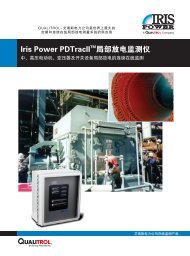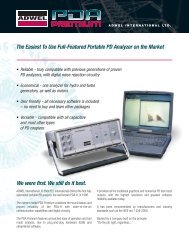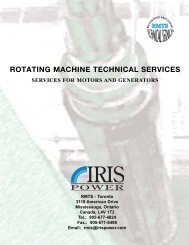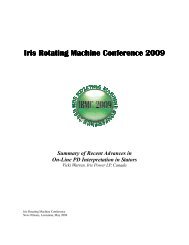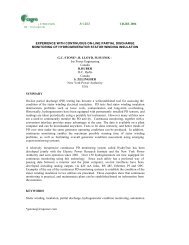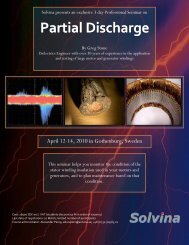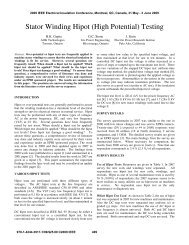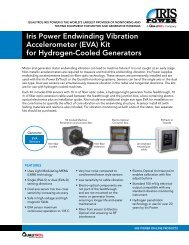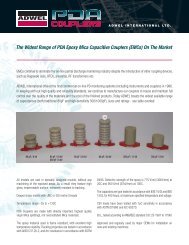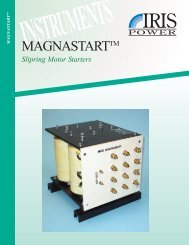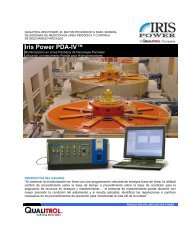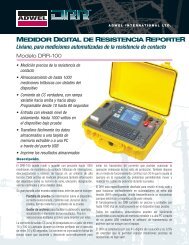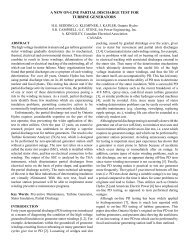Effect of Stator Winding Temperature on Modal Test Results IRMC ...
Effect of Stator Winding Temperature on Modal Test Results IRMC ...
Effect of Stator Winding Temperature on Modal Test Results IRMC ...
Create successful ePaper yourself
Turn your PDF publications into a flip-book with our unique Google optimized e-Paper software.
movement <str<strong>on</strong>g>of</str<strong>on</strong>g> the endwinding from normal operati<strong>on</strong> and fault c<strong>on</strong>diti<strong>on</strong> forces and flexibility is required<br />
to allow thermal expansi<strong>on</strong> in all directi<strong>on</strong>s <str<strong>on</strong>g>of</str<strong>on</strong>g> various parts <str<strong>on</strong>g>of</str<strong>on</strong>g> the endwinding due to thermal cycling.<br />
Endwinding Vibrati<strong>on</strong> in Rotating Machines<br />
Vibrati<strong>on</strong> is caused by forces that can be electrical or mechanical in origin. Generally, forces can be<br />
divided in steady state, load change and fault forces. Or, forces can be divided to forces acting <strong>on</strong> the<br />
stator core, individual stator bar/coil in the slot and in the endwinding, phase group <str<strong>on</strong>g>of</str<strong>on</strong>g> bars and<br />
complete endwinding. Based <strong>on</strong> frequency, endwindings can vibrate in two critical ranges, line<br />
frequency, usually produced by mechanical forces and twice line frequency, produced by<br />
electromagnetic forces from current carrying phase c<strong>on</strong>ductors.<br />
Mechanical vibrati<strong>on</strong> is the result <str<strong>on</strong>g>of</str<strong>on</strong>g> rotor rotati<strong>on</strong>: unbalanced or misaligned rotor, damaged bearings,<br />
and electrical problems <strong>on</strong> rotor such as shorted turns in generators and synchr<strong>on</strong>ous motors or broken<br />
bars in squirrel-cage inducti<strong>on</strong> motors [2].<br />
Electromagnetic forces between stator bars are created by current flowing through them.. In normal<br />
service these forces are relatively low and are c<strong>on</strong>tained by suitable end winding support structure.<br />
During large stress events, such as terminal short circuit or synchr<strong>on</strong>izati<strong>on</strong> errors, the current may rise<br />
to 10 times normal rated current and the resulting endwinding forces can be up to 100 times higher<br />
than the normal operating forces. In large turbo generators the forces in normal operati<strong>on</strong> can be as<br />
high as 100 lb/inch or 20,000 N/m <str<strong>on</strong>g>of</str<strong>on</strong>g> bar length, and may rise to more than 50 times those values in<br />
cases <str<strong>on</strong>g>of</str<strong>on</strong>g> severe system disturbances. Note that there are significant differences in forces between top<br />
and bottom bars are in the slot secti<strong>on</strong>, where the bars are at different levels <str<strong>on</strong>g>of</str<strong>on</strong>g> magnetic field. For EW<br />
the differential is not as large and also difficult to evaluate.<br />
Under normal operating c<strong>on</strong>diti<strong>on</strong>s, in most designs, vibrati<strong>on</strong> forces are c<strong>on</strong>trolled and kept at levels<br />
that are not harmful for stator winding. However, overstressing events and aging <str<strong>on</strong>g>of</str<strong>on</strong>g> the stator winding<br />
and its support systems can make it loose and cause a winding natural frequency to approach a forcing<br />
frequency (rotati<strong>on</strong>al speed or twice line frequency) and result in amplified deflecti<strong>on</strong> and relative<br />
moti<strong>on</strong> between comp<strong>on</strong>ents <str<strong>on</strong>g>of</str<strong>on</strong>g> the stator winding. This process can lead to mechanical and electrical<br />
failures.



